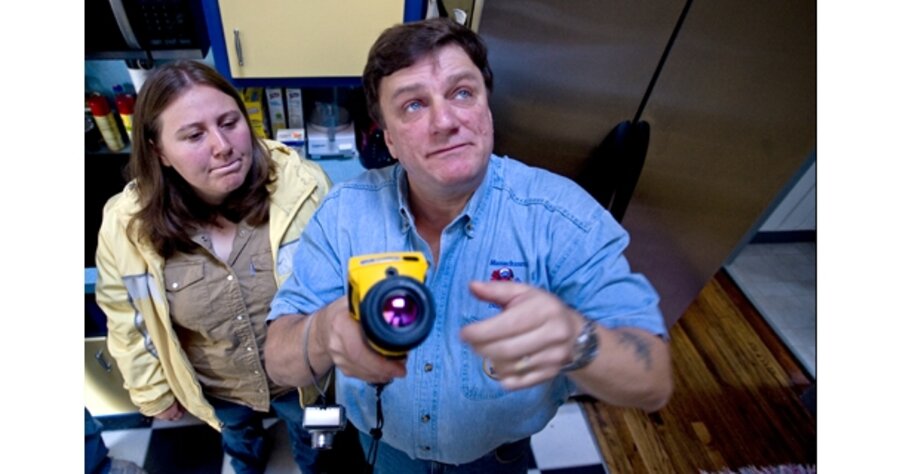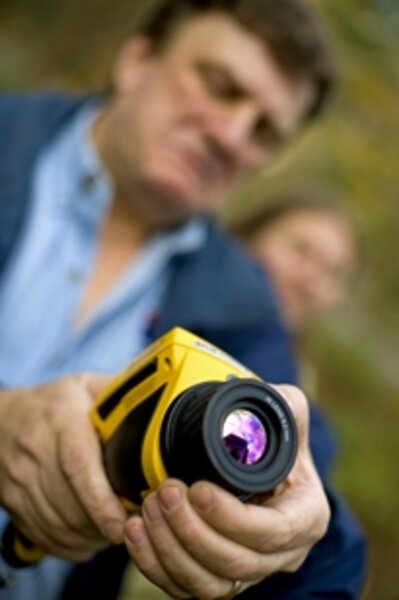Energy audits: A high-tech way to stay warm this winter
| Middleton, Mass.
After home heating oil prices surged last winter, Meghan Kaiserman decided this fall to get ahead of any price spike and go thermal – that is, she chose to get a thermal-imaging home-energy audit.
So, on a recent chilly morning, Ms. Kaiserman and thermal-energy auditor David Valley walked through her large 1940s ranch-style home, stopping every few steps to examine a color screen on Mr. Valley’s camera. The device scans walls and other surface temperatures in the infrared spectrum – heat energy invisible to the human eye – and displays them as colors. Blue, dark purple, and black indicate cold levels; white, orange, and red represent warm areas. Snapshots of walls become part of a home’s thermal documentary.
“See those blue and black streaks set against the orange background – that’s cold air whispering into your house,” Valley says, his finger tracing onscreen an eerie purple line where wood paneling abuts her stone chimney. “This is really you helping to heat the great outdoors.”
Garden-variety home-energy audits have been around since at least the 1970s, of course. Then, as now, it’s still mostly a low-tech job in which a homeowner or contractor embarks on a hands-and-knees hunt for air leaks around electric outlets, window frames, crawl spaces, doors, and fireplace dampers. Any gaps are plugged with caulk or insulation.
But rising home heating prices and falling technology costs have combined in the past year or so to make home-energy audits more high tech and precise than ever.
For $350 to $500, a thermal audit can not only discover where energy is wasted, but also pinpoint mold as well as termite or water damage behind walls.
The audits rely on thermal-imaging technology developed years ago by the US Defense Department to help soldiers spot the enemy at night. For years, big companies also used the technology to spot overheating equipment in factories or leaks in roofs. But only recently have costs dropped to the point where it can be used on the residential commercial level.
The technology, built into the chassis of a digital camera, costs a home inspector about $5,000 today, compared with perhaps $25,000 a few years ago. As a result, a small but growing number of home inspectors have become armed with thermal-imaging cameras.
“Home inspectors across the country are recognizing that this is a technology they can use to make money and provide a more efficient and accurate home inspection,” says Tom O’Toole, business development manager for FLIR Systems of Billerica, Mass., which also makes military and commercial thermal-imaging systems.
Over the past year or two, requests for the technology have soared, says Nick Gromicko, founder of the International Association of Home Inspectors. Of 9,000 home inspectors in the association, about 1,300 are “infrared certified” having completed a course to ensure they can properly identify what the camera is displaying.
“Most folks just want to save money on their heating bill,” Mr. Gromicko says. “We’ve found some people, though, who are using thermal-energy audits to help sell their house. So they can use the report to prove how energy efficient their home is to a prospective buyer.”
Like many home inspectors across the country, Valley isn’t seeing too much inspection work related to home sales these days. But he’s glad that a couple of years ago he bought a thermal camera, took certification courses, and added thermal imaging to his energy-audit service. Now he takes the thermal camera everywhere, including regular home inspections.
“Sometimes people think I can actually see through the wall with this camera,” Valley says. “I can’t, of course, but the temperature differential does reveal what’s going on behind the wall.”
Looking at his camera screen inside Kaisernan’s home, Valley points at dark vertical lines set against an orange (warm) wall. The lines represent wooden studs and darker spots show where the nails are. Darker black areas between the studs show where the fiberglass insulation is sagging, bagging, or missing.
Kaiserman is particularly suspicious of her kitchen wall.
“What about the cabinets?” she wonders. “They turn into a freezer in the winter. All the cups in there are ice cold.”
Sure enough, Valley finds the thermal traces of an air leak high up on the wall through an old vent that had not been plugged properly. Within an hour and a half, Valley has identified nearly every spot inside and outside the home where heat was escaping or cold was intruding.
As part of the service, Valley routinely takes dozens of thermal pictures of each area and regular digital images, too, to make it easier to identify the location of each problem. He then compiles the photos into a report, placing arrows to clearly designate problems. Then it’s a matter of prioritizing areas with the worst air and heat leakage.
In Kaiserman’s case, it’s around the fireplace, by the cupboards, and down in the basement crawl space.
Kaiserman plans to eliminate the worst problems either by blowing insulation into the void behind the wall, or, if necessary, removing part of the wall and putting in fiberglass insulation. The termite damage near her chimney will have to wait until spring, she says.
“I’m really glad I did this,” says Kaiserman, who moved into the house a couple of years ago. “I knew I had some drafts, but I just didn’t know where they were coming from or how to get at them. Now I do.”






